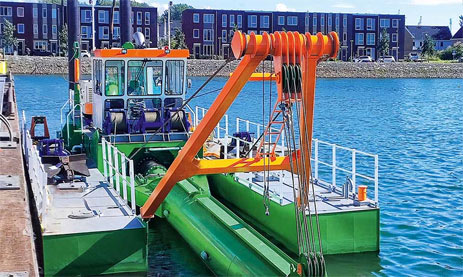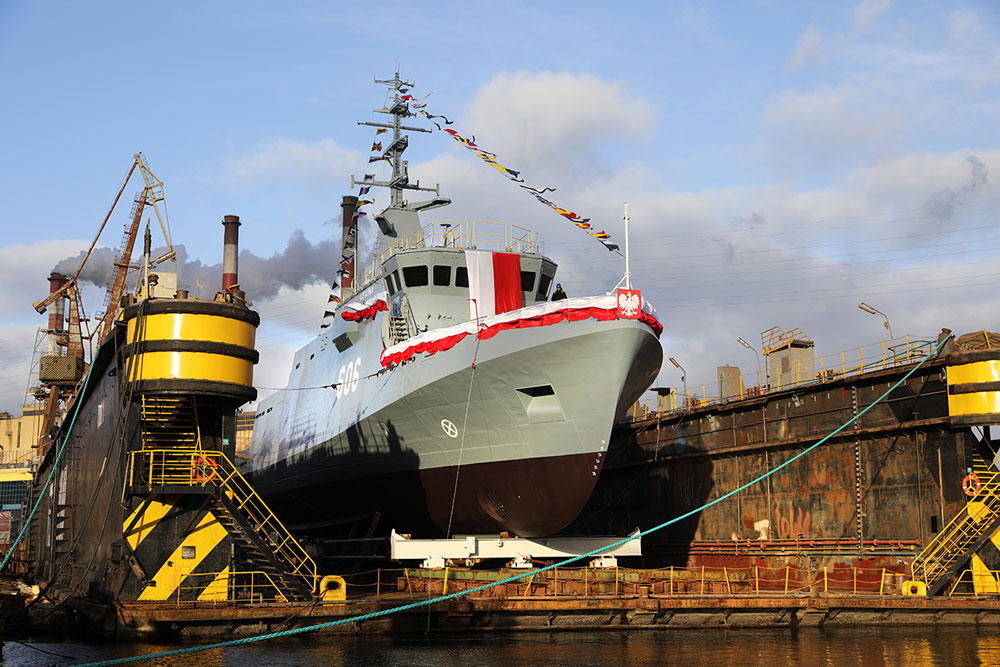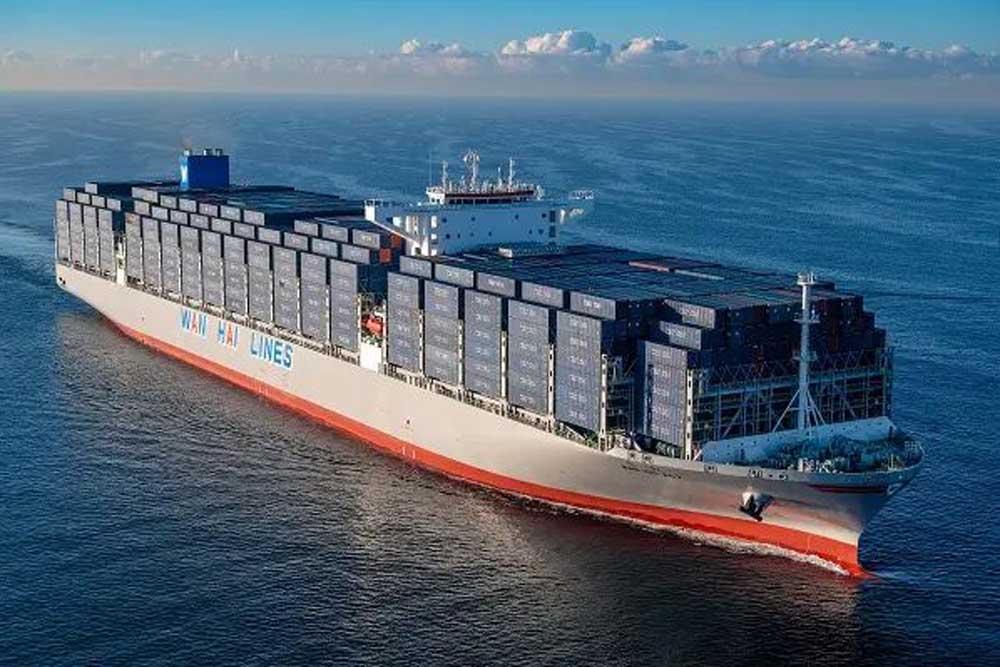The Port of Hamburg handled fewer containers in 2023, while bulk cargo throughput remained stable. Germany’s largest seaport maintains its market share in the North Range.
In addition to the geopolitical and economic challenges that impacted throughput in all North Range ports in 2023, the Port of Hamburg’s business was also affected by the downturn in the German economy and the subdued consumer climate. Container throughput recorded a year-on-year decline in 2023, although there was a slight recovery in the second half of the year. Compared to its Northern European competitors, Hamburg has seen a smaller decline in containerised cargo, allowing the Port of Hamburg to maintain its market share. [ds_preview]
In 2023, a total of 114.3 million tons of goods were handled in the port of Hamburg. Seaborne cargo throughput was, therefore, 4.7 % below the previous year’s level. Exports and imports accounted for 48 and 65.6 million tons, respectively, in 2023. After twelve months, container throughput amounted to 7.7 million TEU compared to 8.3 million TEU in the previous year. This corresponds to a decline of 6.9%. In the first half of 2023, the decline in container throughput was 11.7% compared to the same period in the previous year. “With the development of our handling figures, we are on a par with our Northern European competitors and can hold our own compared to other ports. The decline is primarily due to the difficult geopolitical and economic situation with which all market participants are confronted,” explains Axel Mattern, CEO of Port of Hamburg Marketing. The decline in throughput slowed in the 4th quarter.
At 36.2 million tons (-0.2 % compared to the previous year), the throughput of the bulk cargo remained stable in 2023. With an increase of 8.4% to 6.6 million tons, the agribulk business, in particular, recorded growth. Companies increased handling to 10.6 million tons in the liquid cargo sector. This corresponds to an increase of 6.6 % compared to the previous year. In contrast, the handling of grab cargo fell by 6.2% to 19 million tons. According to the information provided, the reasons for this are, on the one hand, lower electricity generation from coal and, on the other, an overhaul at a steelworks connected to the Port of Hamburg.
Port of Hamburg records losses in China traffic and record handling in the USA
China remains at the top of this list by some distance – albeit with a decline of 12 % last year to a container throughput of 2.2 million TEU. In contrast, US traffic continued its positive development in recent years. A total of 653,000 TEUs were handled with what is now the Port of Hamburg’s second-strongest trading partner in 2023. This corresponds to an increase of 8 % compared to the previous year. The development of throughput with India is also positive. At 191,000 TEU, 5.6% more containers were handled in direct traffic with the world’s most populous country last year. India has thus moved up to eighth place among the Port of Hamburg’s most important trading partners.
The trend towards more container ships in the so-called “megamax class” of 18,000 TEU and above calling at the Port of Hamburg continues. With 272 ships, the number rose by 14.8 % in 2023. “We are delighted that the number of calls by mega container ships in Hamburg increased last year. The fact that so many of the world’s largest container ships call at the Port of Hamburg illustrates the port’s efficiency and reliability,” says Friedrich Stuhrmann, CCO at the Hamburg Port Authority (HPA). “At the same time, this underlines the need to further optimise the infrastructure for these ships and ensure effective maintenance of the Elbe federal waterway.”
The number of calls by large container ships also increased overall. 511 calls by ultra-large container ships of 10,000 TEU or more were recorded in 2023, an increase of 5.1 % compared to the previous year. In addition, the number of very large container ships (8,000 to 9,999 TEU) and Panamax container ships (4,000 to 5,999 TEU) at the Hamburg terminals increased sharply (23.1% and 36.7% respectively).
Hinterland traffic and transshipment in the red
With a volume of 5.1 million TEU, hinterland traffic in the Port of Hamburg recorded a drop of 4.7 %. Transhipment traffic (2.6 million TEU, -10.9 % compared to the previous year), which had already proven to be volatile in the past, fell more sharply.
Despite operational challenges such as strikes and severe bad weather, rail transported a total of 45.6 million tons (-3.6%) of goods and merchandise via “Europe’s largest rail port”. In terms of the modal split, this mode of transport is still clearly ahead of trucks (38.1 %) and inland waterway vessels (8.4 %), with a share of 53.5 %.
A similar picture emerges in the container sector: last year, 2.5 million TEU went to or came from the hinterland of the Port of Hamburg by rail. This corresponds to a decrease of 6.4 %. This means that rail transported almost half (49.7 %) of all containers in hinterland traffic, while 47.9 % were handled by road and 2.4 % by inland waterway.
Comments on the handling balance: “No state to rest on”
On the occasion of the presentation of the Port of Hamburg’s handling figures for 2023, Alexander Geisler, Managing Director of the Hamburg and Bremen Shipbrokers’ Association, said: “First of all, it should be noted that the Port of Hamburg is roughly in line with its market competitors on the West Range with the results presented. There are, therefore, hardly any shifts in the actual market shares, which is pleasing. Nevertheless, this is not a situation to rest on. The slump in transhipment traffic in particular is alarming and should be a wake-up call.” Of course, the loss of the Russian market plays a role here, but the “migration” is continuing. In addition to the general political and economic development, the better operating conditions at other locations e.g. increased multi-fuel bunker options and higher productivity at the terminals, are also decisive for this. “The Port of Hamburg urgently needs to catch up here. Its pioneering role in the expansion of shore power facilities is remarkable, but shore power connections do not generate throughput. The Port of Hamburg now needs a determined productivity offensive at all levels,” said Geisler.
Sonja Jacobsen, Chairwoman of the FDP in Hamburg, used the port’s balance sheet to criticize the red-green coalition in the city-state. In view of the downward trend in key figures, it is incomprehensible “that the red-green coalition continues to rest on its laurels when it comes to port policy”. Crucial infrastructure measures such as the deepening of the Elbe and the A26 East should not be called into question by disputes between the coalition partners. “It is now up to the Senate to push for a fast rail link between Hamburg and Hanover in the Bundesrat. The SPD in Lower Saxony has sidelined this important project for selfish reasons. Mayor Tschentscher must ensure that the railways get moving again so that the urgently needed capacities for freight traffic are freed up. A good hinterland connection is important for the Port of Hamburg and therefore also for many thousands of jobs in Lower Saxony,” said Jacobsen.














